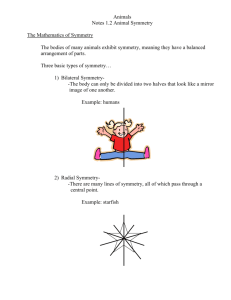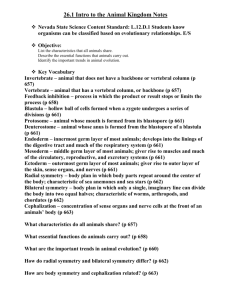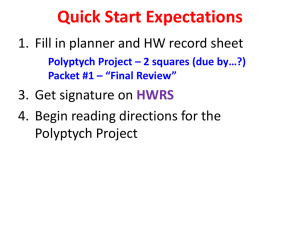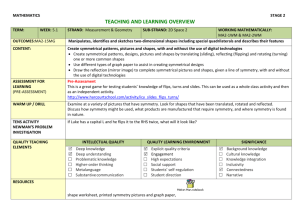Animal Symmetry
advertisement
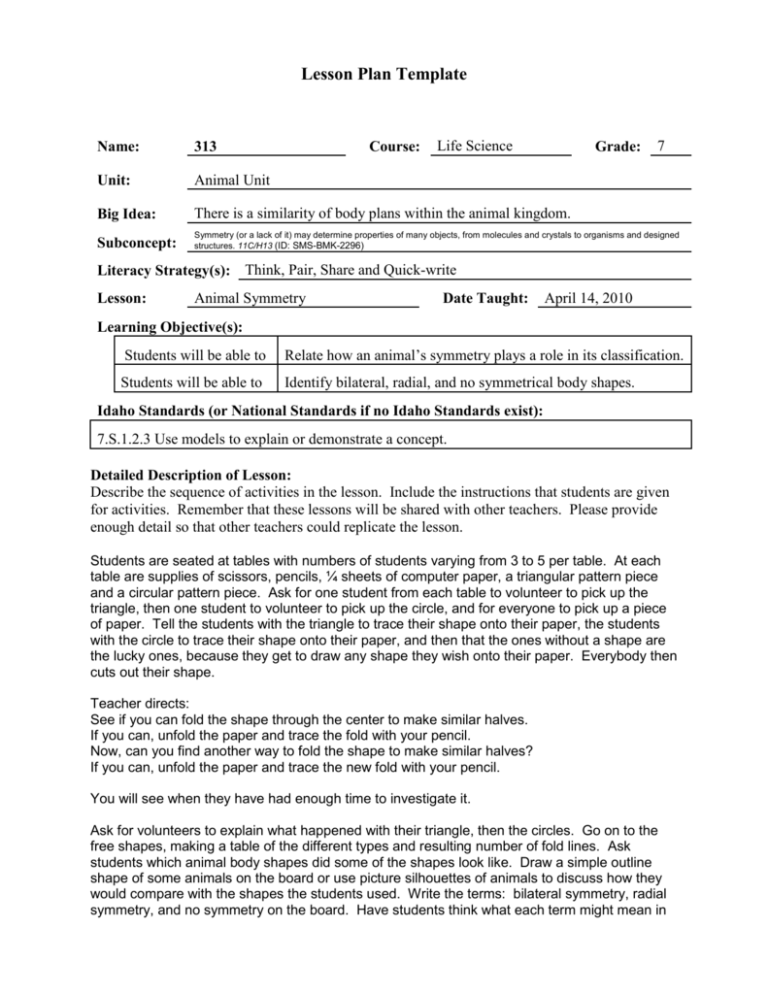
Lesson Plan Template Course: Life Science Grade: 7 Name: 313 Unit: Animal Unit Big Idea: There is a similarity of body plans within the animal kingdom. Subconcept: Symmetry (or a lack of it) may determine properties of many objects, from molecules and crystals to organisms and designed structures. 11C/H13 (ID: SMS-BMK-2296) Literacy Strategy(s): Think, Pair, Share and Quick-write Lesson: Animal Symmetry Date Taught: April 14, 2010 Learning Objective(s): Students will be able to Relate how an animal’s symmetry plays a role in its classification. Students will be able to Identify bilateral, radial, and no symmetrical body shapes. Idaho Standards (or National Standards if no Idaho Standards exist): 7.S.1.2.3 Use models to explain or demonstrate a concept. Detailed Description of Lesson: Describe the sequence of activities in the lesson. Include the instructions that students are given for activities. Remember that these lessons will be shared with other teachers. Please provide enough detail so that other teachers could replicate the lesson. Students are seated at tables with numbers of students varying from 3 to 5 per table. At each table are supplies of scissors, pencils, ¼ sheets of computer paper, a triangular pattern piece and a circular pattern piece. Ask for one student from each table to volunteer to pick up the triangle, then one student to volunteer to pick up the circle, and for everyone to pick up a piece of paper. Tell the students with the triangle to trace their shape onto their paper, the students with the circle to trace their shape onto their paper, and then that the ones without a shape are the lucky ones, because they get to draw any shape they wish onto their paper. Everybody then cuts out their shape. Teacher directs: See if you can fold the shape through the center to make similar halves. If you can, unfold the paper and trace the fold with your pencil. Now, can you find another way to fold the shape to make similar halves? If you can, unfold the paper and trace the new fold with your pencil. You will see when they have had enough time to investigate it. Ask for volunteers to explain what happened with their triangle, then the circles. Go on to the free shapes, making a table of the different types and resulting number of fold lines. Ask students which animal body shapes did some of the shapes look like. Draw a simple outline shape of some animals on the board or use picture silhouettes of animals to discuss how they would compare with the shapes the students used. Write the terms: bilateral symmetry, radial symmetry, and no symmetry on the board. Have students think what each term might mean in relation to the shapes they used. Then have students pair and share their meanings. Last, using their shape papers, ask students to do a quick write on what symmetry means to them. Handouts: Include any handouts that students were given. None Student Work: Include samples of student work from the lesson (include and identify examples of high, medium, and low quality). See next pages LIMSST Project Literacy Lesson Reflection Form Name: 313 Date lesson was taught: April 14, 2010 Lesson Title/Topic Areas: Animal Symmetry Literacy Strategies Used: (Please discuss what literacy strategies you embedded in this lesson. What were your goals in using these strategies? Be specific and use as much detail as possible.) I used the strategy Think, Pair, Share and quick-write. The goal was to engage the students so that they could really think about not just the definition of symmetry, but to be able to apply it to what they saw. Student Response to the Lesson: (Was the strategy effective? Were students able to read/write as needed in this lesson? What attitudes were displayed? How did specific students and/or the class do? How did the literacy strategy aid in developing student understanding of the topic? Cite specific evidence from the samples of student work) I feel the strategy was effective because all the students were engaged in the lesson. They worked at the folding problem of their own shape, but were also very interested how they compared to the results of other students. They felt more comfortable sharing their results with others, before being asked to demonstrate their knowledge of symmetry for the teacher. Lesson Reflection: (What worked well with this lesson? What challenges did you encounter in this lesson? Would you change certain aspects of the lesson or the questions that you asked? How does this influence future lesson planning?) I think most everything when well. The challenge would be judging how long to allow for them to investigate their shapes and how much time to allow for think, pair, share. I think next time I will ask them to write specifically about their shape before pairing and sharing and then go on to write about symmetry in general. Relationship to Previous Instruction: (Have you taught this lesson/topic prior to the LIMSST project? If so, how did your teaching of this lesson differ from what you taught before? How did students’ reactions to this lesson differ?) I had taught animal symmetry before, but mostly students just read the text, followed by worksheet review. This year students were much more engaged and using the quick write assessment, I believe they showed a better understanding of the concept using the think, pair, share along with the hands-on activity.




